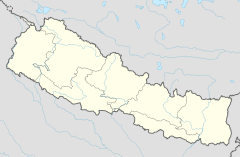Suklaphanta Game Reserve
| Suklaphanta Game Reserve | ||
|---|---|---|
|
|
||
| Location: | Nepal | |
| Surface: | 305 km² | |
| Founding: | 1973 | |
| Suklaphanta game reserve with buffer zones | ||
The Suklaphanta Game Reserve , also called Suklaphanta Wildlife Reserve , is a game reserve in Nepal . It covers an area of 305 square kilometers and consists of grasslands, forests, river valleys and tropical wetlands at altitudes between 74 and 1,386 meters. The game reserve was established in 1973 as the Royal Suklaphanta Wildlife Reserve . The boundaries of the game reserve have been set so that the reserve's game population can migrate into the Siwaliks , the outermost foothills of the Himalayas. The southern and western borders of the game reserve are identical to the border with India. In the south there is also the Kishanpur Game Reserve , which was set up in India as part of the protection measures for tigers.
climate
The climate of the region is subtropical monsoon climate with an annual rainfall of 1,579 millimeters. The monsoon season falls from June to September, with most rainfall in August. The winter months of December and January are relatively cold. The daytime temperatures fluctuate between 7 and 12 ° C, with occasional frost. From February the daytime temperatures rise, in March daytime temperatures up to 25 ° C and towards the end of April also 42 ° C.
vegetation
The game reserve is named after the grassland ( sukla Phanta ), which makes up about 16 square kilometers of the area. It is the largest contiguous grassland area in Nepal. The most important grass species include Imperata cylindrica and Heteropogon contortus . Reed ( Phragmites ) and Sachharum spontaneum grow in the reed beds of the seven small lakes. The forests consist mainly of sage trees . Gerber acacia and dalbergia grow on the river banks .
fauna
The vast open grasslands and wetlands around the lakes are home to several rare animal species. There are 27 different types of fish in the rivers, lakes and ponds. The swamp crocodile, classified as endangered, and tiger pythons also live here . Bengal monitors , spectacled snakes and kraits can also be found in the area of the game reserve .
Mammals
The mammalian fauna comprises a total of 46 species, 18 of which fall under the Washington Convention on the Protection of Species . These include, among others, the Bengal tiger , leopard , sloth bear , Barasingha , Asian elephant and the bristle rabbit , which was meanwhile believed to be extinct worldwide. Due to the rarity of the bristle rabbit, its occurrence in the game reserve is of international importance. The stock of barasinghas is the largest in the world.
Some Indian rhinos from Chitwan National Park were settled in the area of the Suklaphanta Game Reserve in order to establish a third, viable population on Nepalese territory. Eight rhinos were counted in the spring 2015 census.
Avifauna
So far, 423 different bird species have been counted in the area of the game reserve. The reserve represents the western limit of distribution of rare marsh Fran Kolin . Even the Jerdon-Schmätzer ( Saxicola jerdoni ), the cat grass singer ( Griminicola bengalensis ), the Rotkäppchentimalie ( Timalia pileata ) and the Goldaugentimalie ( Chrysomma altirostre ) have here their westernmost distribution area. The game reserve is also the eastern distribution area for the large-billed weaver ( Ploceus megarhynchus ) and the most important wintering area of the mat-tattering ( Saxicola insignis ).
Among the more frequently represented in the area include bird species Water Rail , Yellow Wagtail , Little Grebe , Eastern Grass Owl , laughing dove , Bart Trappe , Curlew and nude reins singer ( Chaetornis striatus ).
literature
- Tej Kumar Shrestha: Wildlife of Nepal - A Study of Renewable Resources of Nepal Himalayas. Tribhuvan University, Kathmandu 2003, ISBN 99933-59-02-5 .


